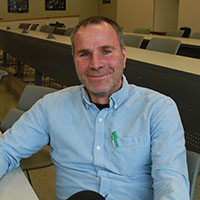
Faculty Developer and Host: Dr. Costel Constantin, Physics and Astronomy

Fall semester (10/3-11/18) availability: Tuesdays and Thursdays
Spring semester (1/30-4/28) availability:TBD
Description
Have you ever wondered how much plastic end up in our oceans every year? Well, it turns out that 11 million metric tons end up in our oceans. That is the same as the weight of 22 World Trade Center buildings. Plastic pollution in general is a big problem we need to look into addressing and one possible solution is to recycle plastic by converting it into construction building materials such as lumber, bricks, floor tiles, fences, roofing tiles, and others. Plastic has several qualities which qualify it as a viable building material including water/corrosion resistance, electrical/thermal insulator, and it is very durable (i.e. it can last for as long as 500 years). In this session, students will learn about plastic pollution and how to construct a plastic brick by using simple household appliances. By the end of this session, students will develop an appreciation for recycling plastic into useful construction materials which can be used for building durable, long lasting houses.
Overview of What Your Students Will Be Doing
-
Introduction to plastic waste in the oceans
-
Background information about plastics (i.e. polymers), and recycling number.
-
Introduction to how we can recycle plastics into building materials
-
Experiment 1: Students will form monopolymers and copolymers
-
Discussion about lab safety
-
Experiment 2: Making a brick from recycled plastics. Note-This lesson will focus on the real-world practices and potential of using recycled practice to make building materials; however, as an added bonus, we are currently working with our Engineering department to see if we can create a mold so that students can use their product to make a JMU key chain to take with them- this is still TBD.
Differentiation
Both high school and middle school students will work in groups. High school students will have more liberty in using the equipment for melting plastic, while middle school students will be supervised closely.
Helpful Background Knowledge
- Basic understanding of how plastics are made out of polymers
- Basic understanding of how polymers are made out of molecules of atoms which are interconnected through chemical bonds.
- Basic understanding of the root of the plastic pollution in the world. For example, human beings are very good at creating plastic bottles for single use, but not realizing that such a plastic bottle will take more than 200 years to degrade after it has been sequestered into the ground as garbage.
Transferable STEM Skills Practiced
The process of science: Students will learn how the plastic obtained from petroleum products
Engineering design thinking: Students will learn how to recycle plastic and convert it into a construction brick to be used in building residential houses.
Molten chemistry and lab safety: Students will learn how to work with molten plastics; these are practices used in a variety of STEM applications.
Cross-Disciplinary Connections
Chemistry: Students will learn that plastics are made through the process of polymerization
Physics: Students will learn about the mechanical properties of plastics
Environmental Science: Students will learn about the environmental impact of plastics pollution and what can we do to alleviate this problem.
Connections to Dr. Constantin's teaching and research interests
In addition to Dr. Constantin's research on nanotechnology, he also has a strong interest in educating young learners about the importance of environmental stewardship. Dr. Constantin is a big advocate in reducing plastic pollution and he encourages students of all ages to use reusable water bottles and to recycle plastic as much as possible.
Examples of Connections to Solving Real-World Challenges
In the next decades, humanity will have an unique opportunity to reverse plastic pollution and convert it into useful building materials. The more our kids know about the harms of plastic pollution, the easier it will be to reverse or to completely eliminate ocean pollution.
In addition, these experiments that students will perform during this session are a close replica to how building materials are constructed from recycled plastics. For example the company Bob Villa constructs outdoor chairs and tables from recycled plastics. See examples .
Related Careers
There are quite a few careers that our students can embrace in their future and for example becoming a material or a chemical engineer can bring a lot of satisfaction. This link shows what it takes to have such careers.
To Share with Your Students Before the Visit
This is a powerful video that provides a good background on plastic pollution.
Extra Background Information for Teachers
This video shows the kind of experiment their students will be engaged in.
